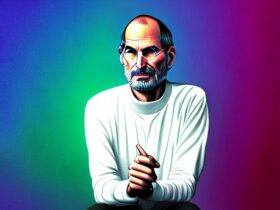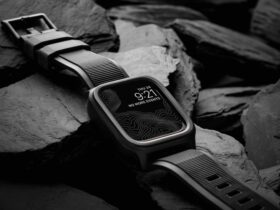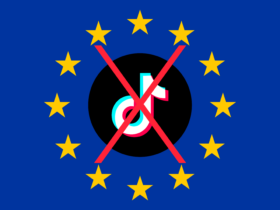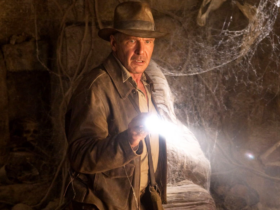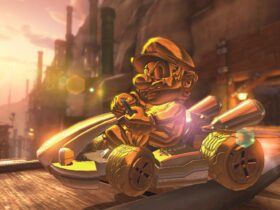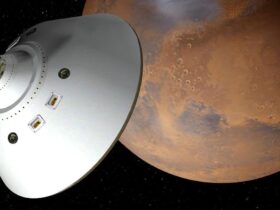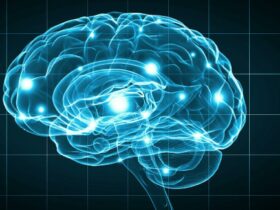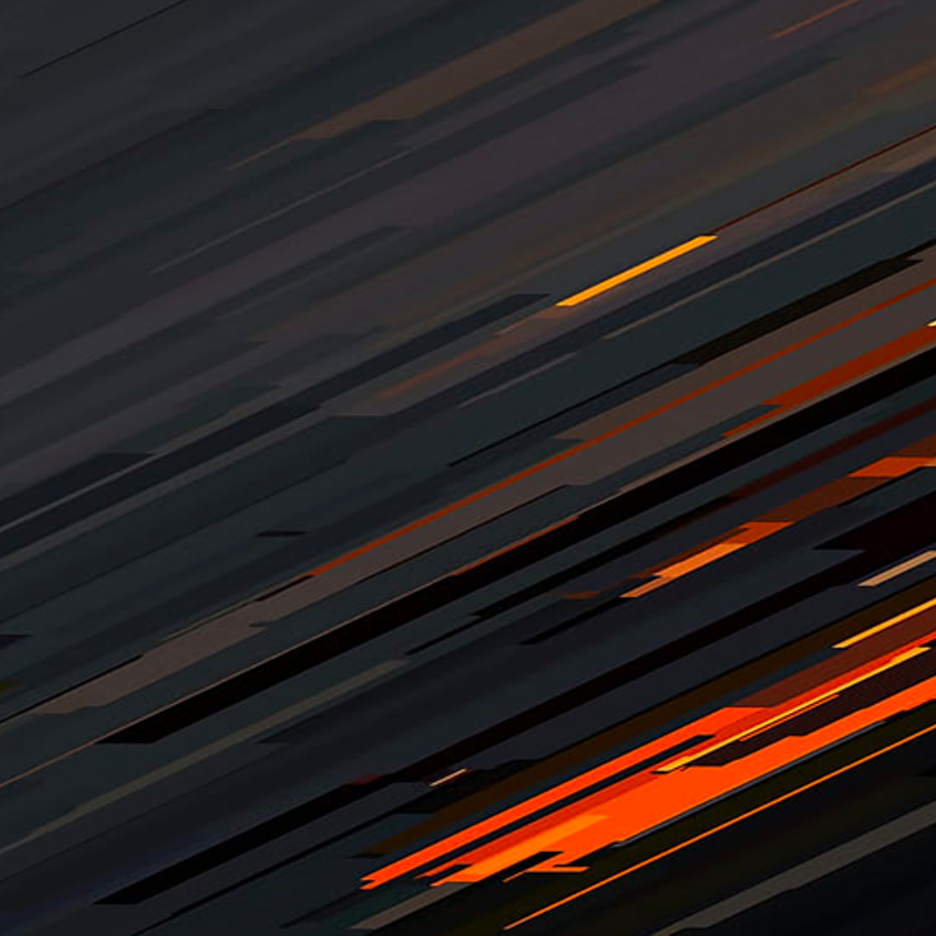Would we see Neanderthals (ideal) as human if they were all-around currently? wikipedia, CC BY-SA
READER Query: We now know from evolutionary science that humanity has existed in some variety or an additional for all-around 2 million decades or far more. Homo sapiens are comparatively new on the block. There were being also several other human species, some which we interbred with. The concern is then inescapable – when can we declare personhood in the extended tale of evolution? Are Chimpanzees people today? Did Australopithecine have an afterlife? What are the implications for how we feel about legal rights and religion? Anthony A. MacIsaac, 26, Paris, France.
In our mythologies, there’s often a singular moment when we grew to become “human”. Eve plucked the fruit of the tree of information and acquired consciousness of fantastic and evil. Prometheus created adult men from clay and gave them hearth. But in the modern origin tale, evolution, there’s no defining second of development. As a substitute, people emerged slowly, generation by era, from before species.
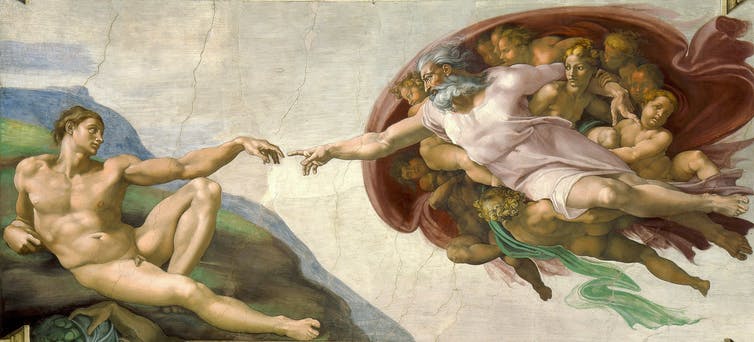
The generation of Adam by Michelangelo.
wikipedia
As with any other complicated adaptation – a bird’s wing, a whale’s fluke, our possess fingers – our humanity evolved step by phase, in excess of millions of decades. Mutations appeared in our DNA, distribute through the population, and our ancestors little by little grew to become anything more like us and, lastly, we appeared.
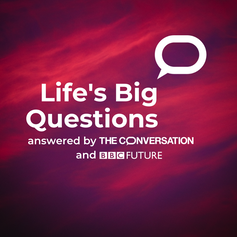
This report is aspect of Life’s Significant Issues
The Conversation’s new sequence, co-printed with BBC Long term, seeks to solution our readers’ nagging questions about daily life, appreciate, death and the universe. We do the job with qualified researchers who have dedicated their lives to uncovering new perspectives on the concerns that condition our life.
Unusual apes, but however apes
Men and women are animals, but we’re as opposed to other animals. We have elaborate languages that let us articulate and connect tips. We’re creative: we make art, music, applications. Our imaginations enable us imagine up worlds that when existed, dream up worlds that might still exist, and reorder the external earth according to individuals feelings. Our social lives are sophisticated networks of people, close friends and tribes, connected by a sense of duty in the direction of each and every other. We also have awareness of ourselves and our universe: sentience, sapience, consciousness, whichever you simply call it.
And yet the difference amongst ourselves and other animals is, arguably, synthetic. Animals are more like human beings than we could imagine – or like to feel. Practically all behaviour we the moment regarded unique to ourselves are found in animals, even if they’re considerably less effectively developed.
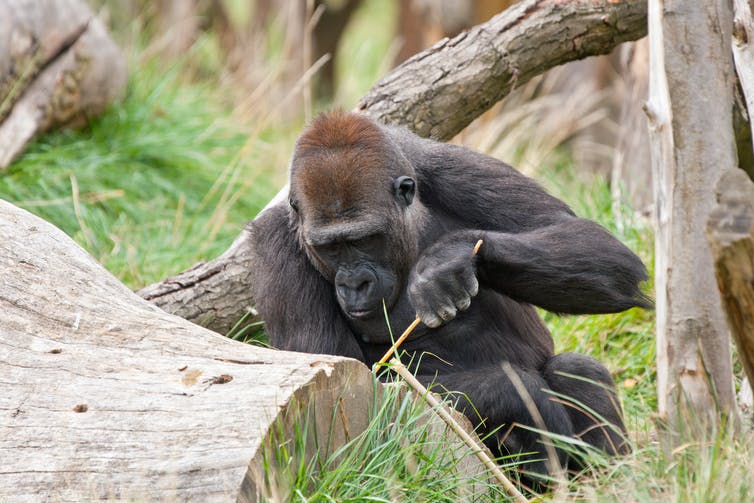
Gorillas use applications far too.
dean bertoncelj/Shutterstock
Which is specifically correct of the great apes. Chimps, for illustration, have basic gestural and verbal conversation. They make crude applications, even weapons, and distinct groups have distinctive suites of resources – distinctive cultures. Chimps also have intricate social lives and cooperate with each and every other.
As Darwin mentioned in Descent of Gentleman, pretty much all the things odd about Homo sapiens – emotion, cognition, language, applications, culture – exists, in some primitive kind, in other animals. We’re different, but considerably less distinctive than we consider.
And in the earlier, some species were much additional like us than other apes – Ardipithecus, Australopithecus, Homo erectus and Neanderthals. Homo sapiens is the only survivor of a once numerous group of humans and human-like apes, the hominins, which involves all over 20 acknowledged species and almost certainly dozens of unknown species.
The extinction of those people other hominins wiped out all the species that have been intermediate amongst ourselves and other apes, developing the impression that some vast, unbridgeable gulf separates us from the rest of existence on Earth. But the division would be much less distinct if individuals species however existed. What appears to be like a brilliant, sharp dividing line is truly an artefact of extinction.
The discovery of these extinct species now blurs that line yet again and shows how the distance concerning us and other animals was crossed – progressively, around millennia.
The evolution of humanity
Our lineage likely split from the chimpanzees around 6 million years back. These initially hominins, customers of the human line, would barely have appeared human, even so. For the initially handful of million many years, hominin evolution was gradual.
The 1st huge change was walking upright, which allow hominins transfer away from forests into more open grassland and bush. But if they walked like us, almost nothing else indicates the first hominins were being any far more human than chimps or gorillas. Ardipithecus, the earliest perfectly-recognized hominin, had a mind that was a bit more compact than a chimp’s, and there is no proof they used equipment.
In the upcoming million years, Australopithecus appeared. Australopithecus had a a bit more substantial brain – greater than a chimp’s, still scaled-down than a gorilla’s. It created slightly more subtle equipment than chimps, utilizing sharp stones to butcher animals.
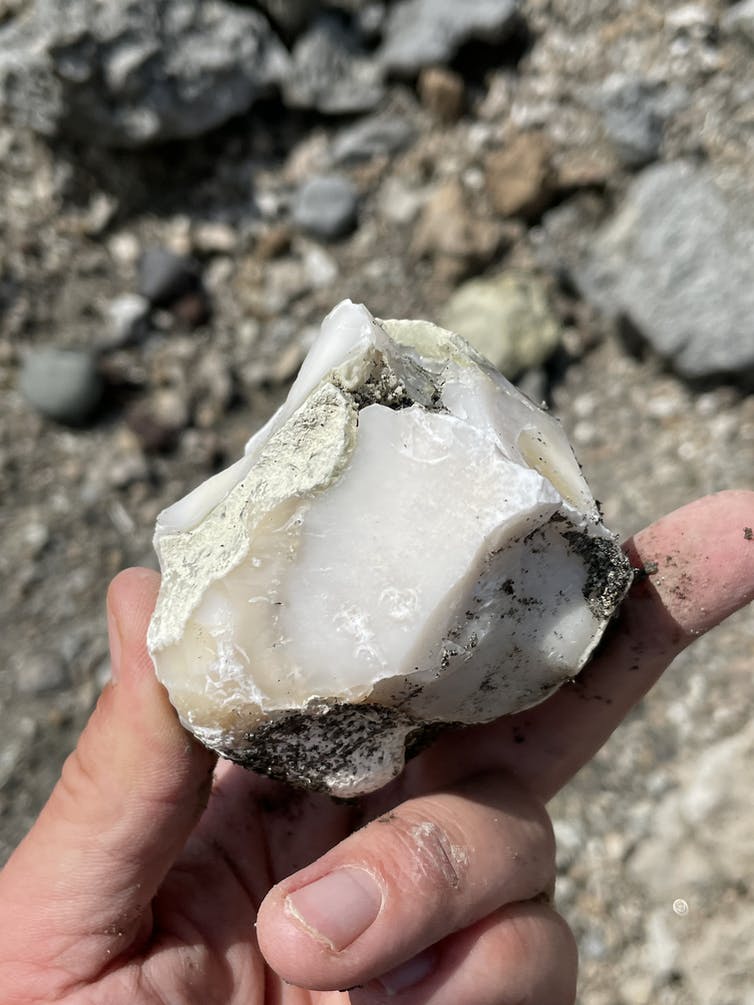
Core from which sharp flakes have been struck off, most likely by H. habilis. Olduvai Gorge, Tanzania.
Nick Longrich, Creator supplied
Then came Homo habilis. For the initial time, hominin brain dimension exceeded that of other apes. Instruments – stone flakes, hammer stones, “choppers” – turned a great deal more advanced. Right after that, around 2 million years ago, human evolution accelerated, for factors we’re however to have an understanding of.
Major brains
At this level, Homo erectus appeared. Erectus was taller, much more like us in stature, and experienced large brains – various periods larger than a chimp’s mind, and up to two-thirds the size of ours. They manufactured complex resources, this kind of as stone handaxes. This was a important technological advance. Handaxes necessary skill and setting up to create, and you likely experienced to be taught how to make one. It may possibly have been a meta-tool – utilized to vogue other equipment, these kinds of as spears and digging sticks.
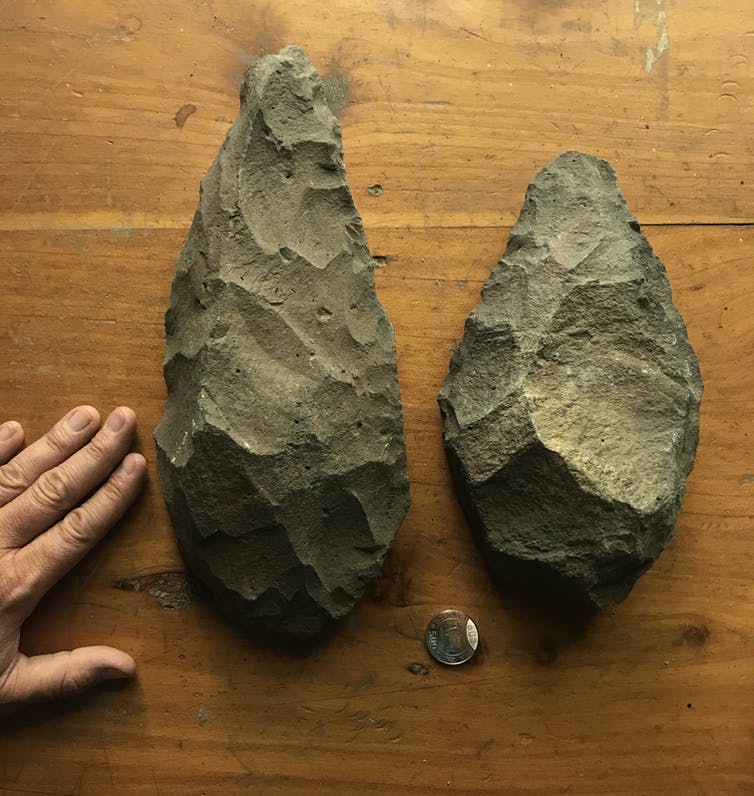
Handaxes built by Homo erectus, from Lake Natron, Tanzania.
Nick Longrich, Writer supplied
Like us, Homo erectus had modest enamel. That indicates a shift from plant-dependent meal plans to feeding on extra meat, almost certainly from searching.
It’s below that our evolution looks to speed up. The large-brained Erectus shortly gave rise to even bigger-brained species. These hugely intelligent hominins unfold via Africa and Eurasia, evolving into Neanderthals, Denisovans, Homo rhodesiensis and archaic Homo sapiens. Technologies turned considerably additional sophisticated – stone-tipped spears and firemaking appeared. Objects with no apparent functionality, this sort of as jewellery and artwork, also showed up around the earlier half-million yrs.
Some of these species ended up startlingly like us in their skeletons, and their DNA.
Homo neanderthalensis, the Neanderthals, had brains approaching ours in size, and developed even greater brains around time until eventually the final Neanderthals had cranial capacities similar to a modern-day human’s. They may well have assumed of them selves, even spoke of them selves, as human.
The Neanderthal archaeological record records uniquely human conduct, suggesting a mind resembling ours. Neanderthals were being proficient, multipurpose hunters, exploiting everything from rabbits to rhinoceroses and woolly mammoths. They created advanced applications, these types of as throwing spears tipped with stone points. They fashioned jewelry from shells, animal teeth and eagle talons, and built cave artwork. And Neanderthal ears had been, like ours, adapted to listen to the subtleties of speech. We know they buried their useless, and likely mourned them.
There is so a great deal about Neanderthals we don’t know, and hardly ever will. But if they ended up so like us in their skeletons and their conduct, it is sensible to guess they could have been like us in other means that really do not leave a record – that they sang and danced, that they feared spirits and worshipped gods, that they questioned at the stars, told stories, laughed with good friends, and beloved their kids. To the extent Neanderthals have been like us, they need to have been capable of acts of wonderful kindness and empathy, but also cruelty, violence and deceit.
Much fewer is recognised about other species, like Denisovans, Homo rhodesiensis, and extinct sapiens, but it’s acceptable to guess from their massive brains and human-seeking skulls that they had been also quite considerably like us.
Adore and war
I admit this sounds speculative, but for 1 element. The DNA of Neanderthals, Denisovans and other hominins is located in us. We met them, and we had little ones with each other. That suggests a large amount about how human they had been.
It is not unattainable that Homo sapiens took Neanderthal girls captive, or vice versa. But for Neanderthal genes to enter our populations, we had to not only mate but correctly raise young children, who grew up to increase youngsters of their possess. That is extra most likely to materialize if these pairings resulted from voluntary intermarriage. Mixing of genes also necessary their hybrid descendants to turn into approved into their groups – to be dealt with as thoroughly human.
These arguments hold not only for the Neanderthals, I’d argue, but for other species we interbred with, together with Denisovans, and unfamiliar hominins in Africa. Which is not to say that encounters in between our species were being with no prejudice, or completely tranquil. We have been possibly dependable for the extinction of these species. But there will have to have been occasions we appeared earlier our variations to locate a shared humanity.
Ultimately, it is telling that while we did swap these other hominins, this took time. Extinction of Neanderthals, Denisovans, and other species took hundreds of countless numbers of many years. If Neanderthals and Denisovans ended up really just silly, grunting brutes, lacking language or complex imagined, it’s not possible they could have held modern day human beings off as lengthy as they did.
The human edge
Why, if they ended up so like us, did we substitute them? It is unclear, which suggests the distinction was one thing that does not go away very clear marks in fossils or stone applications. Probably a spark of creativity – a way with words, a knack for tools, social capabilities – gave us an edge. Whichever the difference was, it was delicate, or it would not have taken us so lengthy to win out.
Even though we don’t know specifically what these discrepancies have been, our exclusive skull condition may provide a clue. Neanderthals experienced elongated crania, with substantial brow ridges. Humans have a bulbous cranium, formed like a soccer ball, and absence brow ridges. Curiously, the peculiar easy, spherical head of grownup Homo sapiens is noticed in young Neanderthals – and even baby apes.
Likewise, juvenilised skulls of wild animals are discovered in domesticated kinds, like domestic canines: an adult dog cranium resembles the cranium of a wolf pup. These similarities aren’t just superficial. Canines are behaviourally like youthful wolves – [less aggressive] and additional playful.
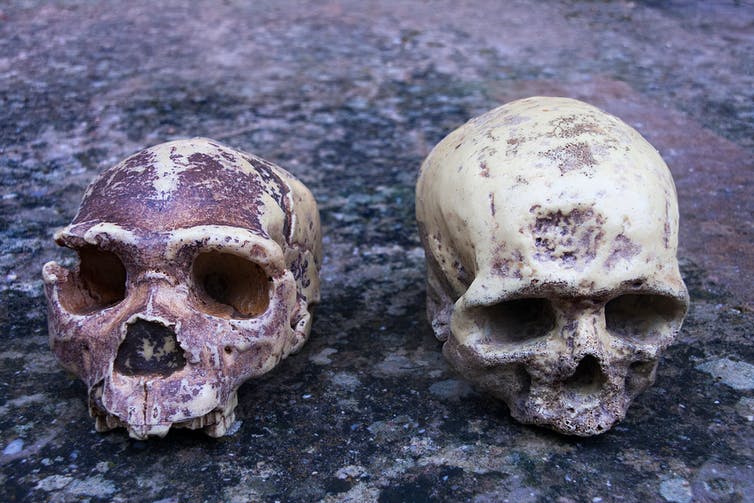
Homo heidelbergensis compared with Homo Sapiens.
Procy/Shuttertock
My suspicion, mainly a hunch, is that Homo sapiens’ edge may not necessarily be raw intelligence, but distinctions in perspective. Like canine, we may perhaps retain juvenile behaviours, items like playfulness, openness to assembly new people today, decreased aggression, more creativeness and curiosity. This in transform may have aided us make our societies greater, far more sophisticated, collaborative, open up and ground breaking – which then outcompeted theirs.
But what is it?
Right up until now, I’ve dodged an critical dilemma, arguably the most significant 1. It is all very well and excellent to focus on how our humanity progressed – but what even is humanity? How can we examine and recognise it, without having defining it?
Individuals have a tendency to presume that there is a thing that will make us basically distinct from other animals. Most people today, for example, would have a tendency to believe that it is all right to offer, cook or consume a cow, but not to do the very same to the butcher. This would be, perfectly, inhuman. As a modern society, we tolerate displaying chimps and gorillas in cages but would be not comfortable undertaking this to each and every other. Likewise, we can go to a shop and obtain a pet or a kitten, but not a child.
The guidelines are unique for us and them. Even die-really hard animal-rights activists advocate animal rights for animals, not human rights. No one is proposing supplying apes the ideal to vote or stand for business office. We inherently see ourselves as occupying a distinctive moral and spiritual plane. We might bury our useless pet, but we would not count on the dog’s ghost to haunt us, or to discover the cat waiting around in heaven.
And however, it’s challenging to find proof for this form of elementary difference.
The term humanity indicates getting treatment of and acquiring compassion for every other, but that is arguably a mammalian excellent, not a human one particular. A mom cat cares for her kittens, and a pet enjoys his master, possibly far more than any human does. Killer whales and elephants form lifelong household bonds. Orcas grieve for their lifeless calves, and elephants have been found checking out the continues to be of their dead companions. Psychological lives and associations are not distinctive to us.
Perhaps it is recognition that sets us apart. But canines and cats absolutely appear to be aware of us – they recognise us as folks, as we recognise them. They understand us properly enough to know how to get us to give them foodstuff, or let them out the doorway – or even when we’ve had a poor working day, and want corporation. If that is not consciousness, what is?
We might level to our massive brains as setting us aside, but does that make us human? Bottlenose dolphins have somewhat much larger brains than we do. Elephant brains are a few occasions the dimension of ours orcas, 4 moments and sperm whales, 5 instances. Brain dimensions also may differ in people. Albert Einstein had a rather compact brain – scaled-down than the average Neanderthal, Denisovan, or Homo rhodesiensis – was he considerably less human? A little something other than mind sizing have to make us human – or maybe there’s additional heading on in the minds of other animals, together with extinct hominins, than we imagine.

Are cats aware?
Vilvarin/Shutterstock, CC BY-SA
We could define humanity in phrases of bigger cognitive skills – artwork, maths, audio, language. This results in a curious difficulty for the reason that humans vary in how very well we do all these items. I’m much less mathematically inclined than Steven Hawking, a lot less literary than Jane Austen, significantly less creative than Steve Employment, significantly less musical than Taylor Swift, much less articulate than Martin Luther King. In these respects, am I much less human than they are?
If we cannot even define it, how can we definitely say in which it begins, and wherever it finishes – or that we’re special? Why do we insist on dealing with other species as inherently inferior, if we’re not accurately positive what makes us, us?
Neither are we essentially the reasonable endpoint of human evolution. We were being a single of several hominin species, and sure, we gained out. But it’s achievable to envision a different evolutionary study course, a distinctive sequence of mutations and historical activities top to Neanderthal archaeologists finding out our peculiar, bubble-like skulls, pondering just how human we ended up.
The mother nature of evolution signifies that living issues do not in good shape into neat groups. Species step by step improve from one into another, and just about every particular person in a species is slightly various – that makes evolutionary modify doable. But that can make defining humanity really hard.
We’re both of those as opposed to other animals because of to pure assortment, but like them mainly because of shared ancestry the same, yet distinct. And we individuals are both equally like and unlike each and every other – united by popular ancestry with other Homo sapiens, various owing to evolution and the exceptional mix of genes we inherit from our family members or even other species, these as Neanderthals and Denisovans.
It is really hard to classify residing points in demanding types, mainly because evolution continually alterations issues, creating varied species, and variety in species.
And what diversity it is.
Accurate, in some methods, our species isn’t that various. Homo sapiens demonstrates much less genetic diversity than your normal bacterial pressure our bodies clearly show less variation in shape than sponges, or roses, or oak trees. But in our conduct, humanity is wildly numerous. We are hunters, farmers, mathematicians, troopers, explorers, carpenters, criminals, artists. There are so several distinctive strategies of being human, so a lot of unique areas to the human problem, and each of us has to outline and find what it indicates to be human. It is, ironically, this inability to outline humanity that is just one of our most human qualities.
To get all of life’s massive answers, sign up for the hundreds of countless numbers of persons who benefit proof-based mostly news by subscribing to our e-newsletter. You can ship us your major queries by e-mail at bigquestions@theconversation.com and we’ll test to get a researcher or qualified on the situation.
Far more Life’s Significant Thoughts:
Joy: is contentment extra essential than goal and targets?
Could we are living in a entire world with no guidelines?
Loss of life: can our remaining instant be euphoric?
Character: have human beings now advanced beyond the normal planet, and do we even now need it?
Love: is it just a fleeting high fuelled by mind chemical substances?
![]()
Nicholas R. Longrich does not perform for, check with, personal shares in or get funding from any business or organisation that would advantage from this report, and has disclosed no appropriate affiliations beyond their tutorial appointment.





